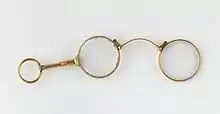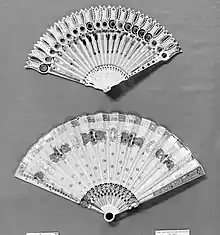Lorgnette
A lorgnette (/lɔːˈnjɛt/) is a pair of spectacles with a handle, used to hold them in place, rather than fitting over the ears or nose. The word lorgnette is derived from the French lorgner, to take a sidelong look at, and Middle French, from lorgne, squinting.[1] They became popularized by Englishman George Adams when he designed a practical case meant to be carried in the pocket.[2]


The lorgnette was usually used as a piece of jewelry, rather than to enhance vision. Fashionable ladies usually preferred them to spectacles. These were very popular at masquerade parties and used often at the opera. They were worn popularly in the 19th century. The lorgnette was employed as a prop and affectation by early 20th century trial lawyer Earl Rogers, and one is featured on the front cover dust jacket of his biography, Final Verdict, by his daughter Adela Rogers St. Johns.[3]
Etymology
This word comes from French lorgnette, from lorgner (to take a sidelong look at), but it is a false friend: the equivalent French name for this (obsolete) optical instrument is un face-à-main while une lorgnette (or une lunette d'approche, une longue-vue) usually means a ship captain's (monocular) telescope.
Description and types

Lorgnettes can typically be identified as a pair of spectacles on the end of a handle.[2] There are many types and forms of the lorgnette. The handles of a lorgnette may vary in length or may be incorporated in various decorative or functional ways.
Lorgnettes were made from a range of different materials including tortoise shell, horn, silver, gold, enamel, and various kinds of jewels.[4] Many lorgnettes had handles which also served as a protective case for the lenses to fold into, therefore making it easier to carry around.
The fan lorgnette and the double lorgnette are examples of variations of the lorgnette.
The fan lorgnette is an accessory where the lorgnette is hidden in the fan and used to inconspicuously observe others.[5] An unusual variant of the fan lorgnette is the French/Spanish “Flirtation Fan” or “Eventail Cocarde” which have a unique use of mirrors and methods of opening and closing.[5]
A double lorgnette (also known as dual purpose lorgnette) consists of two pairs of spectacle lenses of different power, typically one for far-sighted vision and one for near-sighted vision.[6]
History
From its invention to around the 17th century, corrective eyeglasses were mainly for the use of men.[7] It was not common practice for women to use optical aids unless they were to partake in specific activities or tasks in which they were required to use them such as sewing or reading.[4] Women wearing spectacles in public was also not considered attractive.[8]
Following the introduction and popularisation of the lorgnette, women became more involved with the use optical aids. The lorgnette enabled women to view their surroundings clearly, but it was also used for social and decorative purposes. A large portion of the social life of European ladies involved the observation of the people around them, especially the attendance of others at events such as opera or theatre.[5] The lorgnette was part of the elegant games of high society.[9] The use of lorgnettes allowed women of high society to easily scrutinise objects of interest without directly facing their subject.[5]
Invention
The exact specificities of the time, people involved and nature of the invention of the lorgnette is debatable. It is believed that Englishman George Adams I invented the lorgnette in 1770, with his invention depicted in his son’s work “An Essay on Vision” which was first published in 1789.[4] In this work, the lorgnette was described as “a kind of substitute for spectacles. Both eyes are used at once, without any effort”[10] and accompanied with an illustration. It is also mentioned that the lorgnette was contrived to allow for more convenience and ease in looking at any occasional object.[10]
Early versions of the lorgnette were focused on the practicality and functionality of the spectacles to the user due to their round rims and heavier, undecorated designs.[4] However, over time, the lorgnette began to serve as more of a decorative accessory, especially for women attending opera or theatre.[4]
In Fashion and popular culture
%252C_born_Biedermann.jpg.webp)
The lorgnette was presented as a necessity for English women who suffer from shortness of sight as well as a fashionable piece of accessory.[11][8] It was presented as an attractive alternative to conventional eyeglasses and spectacles, which were considered as unbecoming for women to wear out in public.[8] Over time, emphasis of the use of lorgnettes shifted from its practical use to its decorative use.
Lorgnettes were desirable for features such as how they could easily be carried around at one’s own discretion and how they could be quickly taken out and lifted into place on the face to swiftly observe or find answers to questions with grace. [8][6] Lorgnettes were considered to be a great addition to outfits. This was especially so for women preparing their attire to go to the theatre or opera.[6] As a vision aid and fashion statement, it was an accessory that allowed fashionable and vision impaired women to clearly see the action on the stage with ease and to partake in the games of high society.[12][9]
The Duchess of Windsor is said to own a collection of lorgnettes and is said to have brought the lorgnette back to fashion in the 1950s.[6] She is described to be especially fond of a particular lorgnette that “springs out from a small tiger handle of gold, striped in black enamel, emerald-eyed”, designed by Cartier in Paris.[6]
Leonora Corbett, an English actress, is said to own a “diamond set lorgnette that opens when she presses the second diamond from the top of its twisted golden handle” designed by Sterlé of Paris. [6]
In the oil on canvas portrait of Louise von Wertheimstein (Vienna 1813-1890), born Biedermann, she is seen to be holding a lorgnette in her right hand as she poses for her painting.
References
| Wikimedia Commons has media related to Lorgnette. |
- "Lorgnette - Definition and More from the Free Merriam-Webster Dictionary". Merriam-webster.com. Retrieved 21 October 2014.
- Rosenthal, J. William (1996). "Lorgnettes". Spectacles and Other Vision Aids: A History and Guide to Collecting. Norman Publishing. pp. 118–137. ISBN 978-0-930405-71-7.
- Final Verdict by Adela Rogers St. Johns, 1962, Doubleday & Co.
- Handley, Neil. "Lorgnettes and folding eyeglasses". The College of Optometrists.
- Rosenthal, J. Wm. (1995). "Optical uses of fans". In Albert, Daniel M.; Zrenner, Claudia (eds.). History of Ophthalmology. pp. 193–198. doi:10.1007/978-94-011-0127-1_18. ISBN 978-0-7923-3401-9.
- "Fashion: The Lorgnette in Fashion". Vogue. 125 (8): 122, 123, 179. 1 May 1955. ProQuest 911862354.
- Ilardi, Vincent (2007). Renaissance vision from spectacles to telescopes. American Philosophical Society. ISBN 978-0-87169-259-7. OCLC 74966726.
- "The Lorgnette". Harper's Bazaar. 28 (27): 544. 6 July 1895. ProQuest 1914172686.
- Goes, Frank Joseph (2013). Eye in history. Jaypee Brothers. ISBN 978-93-5090-274-5. OCLC 813930522.
- Adams, G. (1789). Essay on Vision. England: Oxford University.
- Cunnington, C. Willett (1990). English women's clothing in the nineteenth century. Dover Publications. ISBN 978-0-486-31963-6. OCLC 853623780.
- "The literary lorgnette: attending opera in imperial Russia". Choice Reviews Online. 38 (3): 38–1475–38-1475. 1 November 2000. doi:10.5860/choice.38-1475.